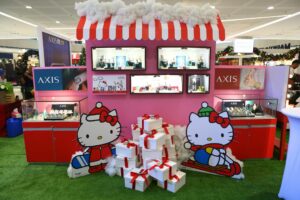Inflation makes us all want to dress like the 1%

By Andrea Felsted
INFLATION has come for dopamine dressing.
That’s the message from the catwalks to TikTok. While the “quiet luxury movement,” characterized by minimalism and understated elegance, is a good look for some high-end brands, it’s a trend many others could do without. For the broader fashion industry, a growing penchant for classic rather than cutting-edge means companies must work harder to attract customers, particularly as the economic backdrop darkens.
For a brief period last year, bright pink pantsuits were everywhere — flushing red-carpet celebs, TV news anchors, and wedding guests alike. It was the result of Valentino designer Pierpaolo Piccioli sending hot-pink creations down the catwalk a year ago.
The exuberance captured the consumer zeitgeist. Freed from pandemic restrictions, shoppers threw off their loungewear and embraced proper clothes once more. With people returning to offices and parties, fashion become fashionable again. Maximalism surged. “Dopamine dressing” — getting outfitted to feel as well as look good — took hold.
But with inflation returning, job losses plaguing tech, and turmoil roiling the banking industry, fashion is becoming passé.
Luca Solca, an analyst at Bernstein, examined the looks sent down the catwalks for the forthcoming autumn-winter season. While bold styles, sneakers, and streetwear dominated last year’s spring fashion month, this year saw the return of timeless dressing and more muted colors. Think well-cut basics, such as blazers, pencil skirts, and tailored pants. For men, sneakers are out. Loro Piana cashmere-trimmed desert boots are in.
The “quiet luxury” hashtag has racked up about 60 million view on TikTok. This coincides with the TV show Succession’s takedown of a large Burberry check handbag and Gwyneth Paltrow’s recent restrained courtroom wardrobe. Old-money chic has displaced opulence.
A more understated fashion cycle can be good for luxury because it encourages consumers to trade up and buy fewer, more expensive pieces, luxury adviser Mario Ortelli told me. But it favors some brands more than others.
Those that have long pursued a more refined aesthetic, such as Italy’s Brunello Cucinelli and LVMH Moet Hennessy Louis Vuitton SE’s Loro Piana, are best placed. Sister brand Loewe’s structured bags are lauded on TikTok, while Kering SA’s Saint Laurent is known for its elegant designs.
Other brands will find this era more challenging. Kering’s Gucci is already shifting from the bold maximalism of former creative director Alessandro Michele to a sleeker aesthetic. The rise of quiet luxury makes this transition — under new designer Sabato De Sarno — all the more pressing. Sister label Balenciaga has also ridden the streetwear wave.
Yet all luxury brands will need to pivot from logo-adorned clothing and accessories to new styles and shapes. Luckily, Burberry Group Plc’s new creative director Daniel Lee developed a raft of such hits while at Bottega Veneta. And the trench coat, Burberry’s signature product, has become emblematic of the new mood. Prada, meanwhile, is known for its elevated minimalism, but it has played on its triangle logo to win over Gen Z. It is already de-emphasizing this for fall.
LVMH’s Louis Vuitton and Dior have top-end positioning and stand a good chance of navigating the new reality. But they too must move away from items with their names emblazoned upon them. LVMH Chief Financial Officer Jean-Jacques Guiony said last week that quiet luxury came around from time to time. He was confident the world’s biggest luxury group had a broad enough portfolio of houses and products to accommodate every taste.
Similarly, Hermes International could emphasize its less obvious bags, which have won fans on TikTok. While Hermes’ Birkin and Kelly models have old-money price tags, they have become so well-known that they now risk looking more nouveau riche.
Limited-edition capsule collections, or collaborations, can inject excitement without deviating from the sparser design ethos, although streetwear tie-ups — including LVMH’s decision to appoint Pharrell Williams as Louis Vuitton’s top menswear designer — may now be less effective.
A minimalist cycle is much more difficult for main street retailers, whose cheaper products have a shorter lifespan. Even though it’s often the garish hues that are left on the sale rail at the end of the season, fashion needs a constant stream of new trends to encourage shoppers to buy. Just look at how it benefited from the post-pandemic shift from skinny jeans to wider-legged styles.
To continue to generate sales, retailers’ design teams must make small refinements to the classics. Yet the faster the fashion, the harder it is to accommodate a slower pace of style iterations.
That said, Inditex looks best placed. It owns the more formal Massimo Dutti. Its flagship Zara brand also operates at the more premium end of fast fashion, giving it credibility with fabric and fit, which become more important for plainer styles. It’s a similar picture at H&M Hennes & Mauritz AB’s COS and Arket brands.
In the US, quiet luxury could help to breathe fresh life into J Crew Group and Banana Republic, whose parent, The Gap Inc., is struggling on many fronts and searching for a new chief executive officer.
Of course, there are some dopamine dressing holdouts. Bright pink “Barbiecore” is still going strong, thanks to the forthcoming Margot Robbie film, although it has been eclipsed by quiet luxury over the past month. And much will depend on whether Chinese consumers use pent-up savings to buy logos or more rarefied wardrobes.
All in all, it’s time to consider the pencil skirt and blazer as alternative economic indicators, alongside surging lipstick sales and longer hemlines. In times of anxiety, everyone wants to look and feel like they have old money. — Bloomberg




